SOME COMBAT APPLICATION OF CHEN STYLE TAIJIQUAN
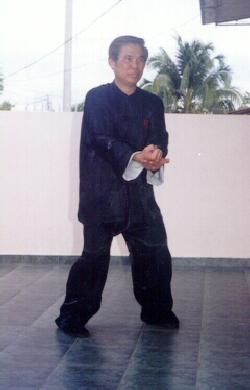
|
Can you please demonstrate some combat application of Chen Style Taijiquan?
There have been some requests to demonstrate combat application of Taijiquan. How the typical Yang Style Taijiquan pattern, Grasping Sparrow's Tail, can be used to overcome all kinds of attacks has been shown.
This webpage explains some combat application of a typical Chen Style Taijiquan pattern, "Immortal Pounds Mortar", illustrated in the photograph on the left. Why do you pound your right fist on your left palm? The answer will become obvious in the applications below.
The combat application of two other Chen Style Taijiquan patterns, "Seven-Star Anchor" and "Slantingly Throw Step", is explained in another webpage.
Taijiquan may be arbitruarily classified into three characteristic traditions, represented by Wudang (pronounced as "wu-t'ang") Taijiquan, Chen Style Taijiquan, and Yang Style Taijiquan and its derivatives, like Wu Style and Sun Style. The emphasis of Wudang Taijiquan is on spiritual cultivation, Chen Style Taijiquan on combat, and Yang Style Taijiquan on health. It should be borne in mind that this generalision is arbitruary -- all genuine Taijiquan is practised for health, combat efficiency and spiritual cultivation.
While Taiji external forms are popularly played today, genuine Taijiquan, especially Wudang Taijiquan, is very rare. This statement can be readily verified by examining at random Taiji practitioners today. A great majority of them not only cannot defend themselves effectively with the art they have learnt, they are also not as healthy and fit as they should be given the time they have spent on their training.
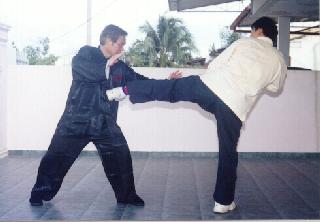
|

|
This is not to say that playing Taiji is useless. Indeed, playing Taiji has served very well the purpose of socialization and recreation. But the point is that playing Taiji is different from Taijiquan training.
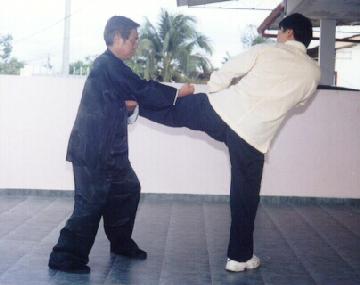
|
The photographs above and on the left illustrate one application of "Immortal Pounds Mortar". As I attempt to strike Goh Kok Hin, he shifts his body backward and executes a side kick known in Shaolin Kungfu as "Happy Bird Hops up a Branch". His is an excellent move, implementing the combative tactic of "no defence direct counter" or pat chew yi ta in Chinese (Cantonese).
Instead of blocking head-on, I employ the Taijiquan philosophy of "flowing with the opponent". Continuing my movement in a curve, I roll back my body, following Goh's kicking momentum. Simultaneously I hook my left hand under Goh's ankle. Immediately I lock his leg against the left side of my body, move forward and pound my fist on his knee. The combative tactic used in the execution of these techniques is known as "defence cum counter" or lin siew tai ta in Chinese (Cantonese).
The photographs below show another application of "Immortal Pounds Mortar".
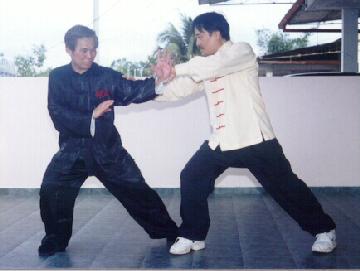
|
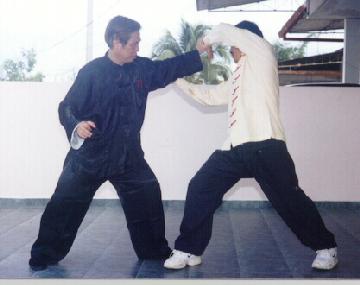
|
During combat Goh Kok Hin grips my left elbow with his right hand and my left wrist with his left hand in a Shaolin kungfu pattern known as "Lead a Horse back to Stable".
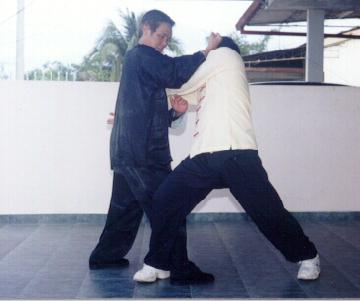
|
Instead of trying to force out my arm, I flow with the opponent by circulating my left arm in an anti-clockwise direction and around Goh's two arms. This action, which is the initial movement of the pattern "Immortal Pounds Mortar", not only frees my left arm from Goh's grip but instead locks Goh's two arms within my left elbow, forearm and the left side of my body. Continuing my movement, and placing my right leg in such a position that Goh cannot kick me, I pound my fist on his left temple.
Notice that the movements of "Immortal Pounds Mortar" in both applications are similar, except that in the first application the circulation of the left arm is smaller (as it is used to lock the opponent's leg), and that in the second application the pounding of the right fist is higher (as it is used on the opponent's temple).
